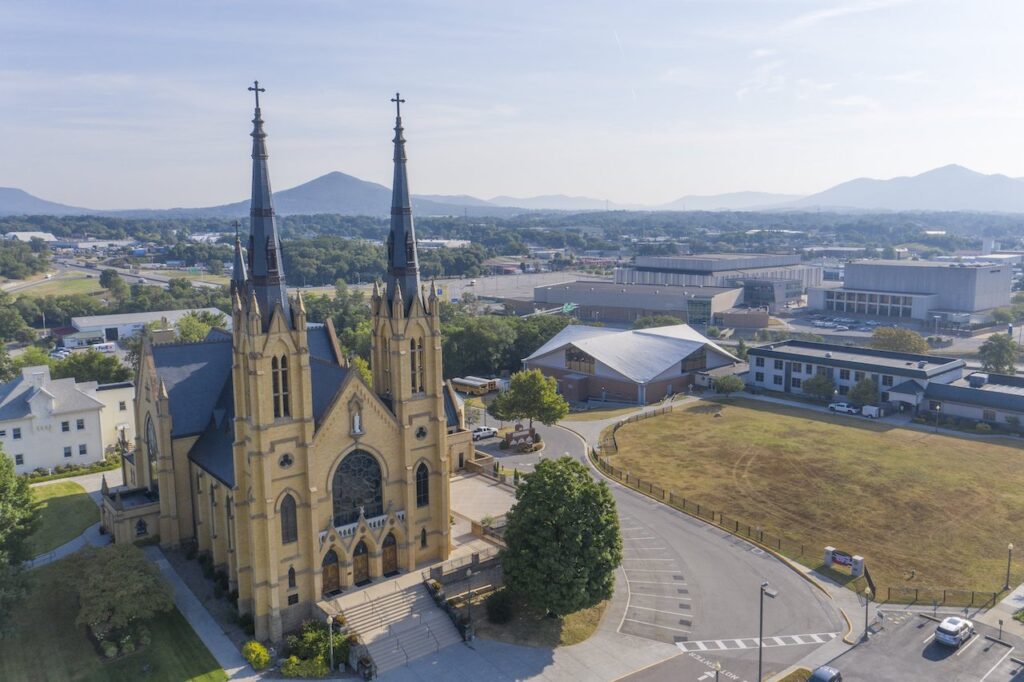More than a decade before I became bishop of the Diocese of Richmond, I would drive from Washington to Roanoke to visit my sister and her family. I remember as I drove toward the city, I would see St. Andrew Church from I-81. Overlooking downtown Roanoke from a mountaintop, its yellow brick and High Victorian Gothic style beautifully captured the sunlight.
It was impossible to miss. Its location, combined with its prominence and architectural quality, make it a visible sign of Catholic presence in the Roanoke Valley.
As an architect, I was curious to see the church, but I wanted to know its history. The building and expansion of the railroads brought Catholics to that area in the late 1800s. Together, they became a parish in 1889. Those who stayed were among the small minority of Catholics who lived in the southwestern part of the Commonwealth but who were not always welcome.
Despite being victims of bigotry, the growing Catholic population was steadfast in its faith. In an instinctive way and with a sense of beauty, worth and pride – in a good way – about their faith, they wanted to share it publicly. Historically, that is one of the reasons why these architectural expressions of faith like that of St. Andrew were built.
There was a period in Maryland and Virginia during which Catholics were not very showy about their faith. They wanted to be at peace with their neighbors, not to be overbearing, and not to impose their beliefs. However, if Catholics’ faith was challenged, which was not uncommon, they were not afraid to express it.
The building of St. Andrew in Roanoke demonstrated recognition of that faith. Bishop Augustine Van de Vyver, the sixth bishop of Richmond, dedicated the church on Nov. 30, 1902, the Feast of St. Andrew. On Thanksgiving Day, Nov. 29, 1906, Bishop Van de Vyver dedicated the Cathedral of the Sacred Heart in Richmond.
Early in my time as bishop of Richmond, as we were preparing for our diocese’s 200th anniversary in 2020, I considered the possibility of pursuing recognition of St. Andrew Church as a basilica. The timing wasn’t right, and COVID further delayed the germination of the idea.
However, once we were able to focus on it, Father Kevin Segerblom, the pastor, and a committee of parishioners developed the detailed written case for recognition as a minor basilica to the Vatican Congregation for Divine Worship and Sacraments. That recognition was granted on Sept. 6.
In seeking designation as a minor basilica, a parish needs to demonstrate uniqueness in its architecture, history or pastoral outreach. St. Andrew Church has merit in each of those areas.
Its artwork and architecture have served as a means of handing on the faith to those who have seen them. Its High Victorian Gothic style and its architectural merits have been lauded for many years, becoming a place of pilgrimage for Catholics and non-Catholics who visit the city.
Historically, St. Andrew Church is nascent to the Roanoke area. That is reflected in its placement in the Virginia Historical Landmarks Register and the National Register of Historic Places in 1972 and 1973, respectively.
Pastorally, it has been a spiritual home for immigrants and refugees since its founding, e.g., Irish immigrants in the late 19th century, Lebanese Catholics in the mid-20th century and Vietnamese Catholics in the 1990s. Their presence and participation have contributed to the vibrancy of the parish.
Further, the faith of the parish community is fortified by prayer, worship and catechesis. Through many parish-based ministries as well as in collaboration with other churches in the valley, parishioners are engaged in outreach and service to people in need.
On the First Sunday of Advent, Dec. 3, we will celebrate St. Andrew Church becoming the 93rd basilica in the United States. We are blessed to have two basilicas in our diocese – the other being the Basilica of St. Mary of the Immaculate Conception in Norfolk, which received that designation in 1991.
The basilicas and the Cathedral of the Sacred Heart are the crown jewels of churches in our diocese. Their architectural prominence in each of the vicariates, along with their historic stature and pastoral commitment, make them lights of faith to the communities in which they are located. Each is like a city on the mountain top; they cannot be hidden (Mt 5:14).
The honor bestowed upon the Basilica of St. Andrew is a reminder that we – individually and as members of parishes – must be that light. This Advent, let that light illuminate your life and those of everyone you meet.

